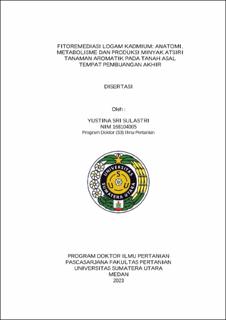Fitoremediasi Logam Kadmium: Anatomi, Metabolisme dan Produksi Minyak Atsiri Tanaman Aromatik pada Tanah Asal Tempat Pembuangan Akhir
Cadmium Metal Phytoremediation: Anatomy, Metabolism and Production of Aromatic Plant Essential Oils in The Soil of Origin of Landfills

Date
2023Author
Sulastri, Yustina Sri
Advisor(s)
Sabrina, T
Mukhlis
Damanik, Revandy Iskandar Muda
Metadata
Show full item recordAbstract
Final shelters as garbage collectors in big cities have now become a
disturbing and even dangerous situation for the health of the surrounding
communities. This situation is due to the heavy metal content contained in the
landfill soil. Therefore, efforts need to be made to reduce the negative impact of
heavy metals in landfill soil. Therefore, it is necessary to remediate heavy metals
by selecting and growing aromatic plants as a phytoremediation tool that is cheap,
easy and adds value economically.
It is necessary to research the extent to which the ability of aromatic plants
that have a specific character can remediate heavy metals, especially in landfills.
In addition, there have been no reports that waste in landfills can affect the
production of essential oils from aromatic plants in Indonesia, especially in North
Sumatra. Thus, the author is interested in researching the ability of aromatic plants
as accumulators of heavy metals while producing high essential oils due to heavy
metal stress in landfills.
The first phase of research has been carried out using random draft of the
group factorial with factor I is a type of aromatic plant consisting of, T1 = fragrant
root (Vetiveria zizanioides), T2 = citronella (Cymbopogon nardus), T3 =
lemongrass (Cymbopogon citratus), T4 = patchouli (Pogostemon cablin), T5 =
ruku-ruku (Ocimum tenuiflorum), factor II is a concentration of heavy metal Cd
consisting of four levels, K0 = 0 ppm, K1 = 85ppm, K2 = 170 ppm, K3 = 255
ppm, K4 = 340 ppm. So that there are 25 combination treatments where each
treatment is made in 3 tests where each experimental unit consists of 3 plants.
Data on essential oil content and heavy metal absorption Cd from the results of
this study were analyzed using IBM SPSS Statistics 20. Then a treatment that
showed a noticeable influence on the observed change was followed by Duncan's
Multiple Range Test (DMRT) test at a confidence level of 5%.
The second phase of research has been carried out using a random design
group factorial which consists of two factors, namely factor 1, which is the source
of TPA land, which consists of three kinds, S0 = Not Landfill Landfill, S1 =
Namo Bintang Landfill Landfill, S2 = Waterfall Landfill Land, Factor II, is the
number of plants per hole consisting of, J1 = one plant per hole, J2 = two plants
per hole, J3 = three plants per hole. In the second study, there were nine
combination treatments were made in 3 tests, and each experimental unit
consisted of 3 plants. Data on essential oil content and heavy metal absorption Cd
from the results of this study and with additional parameters: anatomical test, physiology test, and biochemical test were analyzed using IBM SPSS Statistics
20. Then the treatment that showed a noticeable influence on the changes
observed was followed by Duncan's Multiple Range Test (DMRT) test at a
confidence level of 5%.
The results of the first study showed, some aromatic plants that were tried,
citronella produced the highest essential oil. And there is an increase in the
percentage of essential oil content due to the Cd treatment given, especially to
fragrant root plants and patchouli. Of the five types of aromatic plants assessed,
all plants can be used as phytoremediation tools. Only patchouli has a low
percentage of life rate. Fragrant root showed better growth under Cd pressure,
while citronella showed the highest increase in plant total Cd absorption up to 340
ppm treatment. There is a real and strong correlation between the extraction of Cd
in the root and the total extraction amount of Cd with the essential oil content.
The results of the second study showed that the accumulation of Cd metal in
the roots and in the canopy as well as the extraction of Cd metal, the total
citronella in landfill soils was higher than non-landfill soils and the highest yield
was found in the Waterfall Landfill. Two plants per hole give the highest yield in
Namo Bintang landfill soil based on wet root weight, root dry weight and canopy
root ratio whereas in Waterfall landfill soil and non-landfill soil, three plants per
hole give the highest yield. The highest content of citronella essential oil comes
from the Waterfall Landfill. And the results of the correlation test obtained a real
relationship between the metal content of Cd in the header and the content of
essential oils, as well as there is a real relationship between the wet weight and
dry weight of the roots to the essential oils.
Then for additional parameters results of the third study showed that plants
Citronella plants that were tried on anatomically landfill soil (transverse slices of
the root tip) showed no difference with citronella roots in non-landfill soils.
Physiologically (chlorophyll A amount, root activity) shows higher values than
citronella in non-landfill soils. Biochemically, the MDA content of citronella
growing in landfill soils is higher than the MDA content of citronella growing in
non-landfill soils. This indicates that citronella in landfill soils is experiencing a
state of shock due to cadmium heavy metals.
